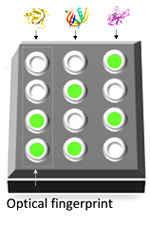Research
Our group applies tools from synthetic organic chemistry and chemical biology to generate functional biomimetics and fluorescent molecular sensors that respond to the presence of specific biomolecules, mainly proteins, in their natural environment.
 Self-assembled biomimetics
Self-assembled biomimetics

In nature, protein tertiary and quaternary structures are governed by the formation of non-covalent yet specific interactions. In our group, the self-assembly of synthetic building blocks, such as DNA-peptide conjugates, is used to project peptides in well-defined orientations, which results in protein mimetics with unique properties. This approach enables us to better understand the parameters that control peptide self-assembly in water, as well as create functional, three-dimensional structures capable of recognizing and modulating important biomolecular interactions.
 Cross-reactive sensor arrays
Cross-reactive sensor arrays

By generating libraries of biomimetic receptors appended with fluorescent groups and recognition elements, we are able to develop cross-reactive sensor arrays (the so-called chemical “noses”/”tongues”) that generate unique optical "fingerprints" for different protein biomarkers. This approach could eventually lead to the analysis of specific protein combinations, which is a sought-after goal in the area of medical diagnostics.
 Fluorescent molecular sensors
Fluorescent molecular sensors

We also develop fluorescent molecular sensors that can detect specific proteins in their native environments. Different photo-physical processes, such as photo-induced electron transfer (PET), internal charge transfer (ICT), and fluorescence resonance energy transfer (FRET) are applied when we design fluorescent 'turn-on' molecular switches that can sense protein biomarkers with high selectivity and signal-to-noise ratios.
 Combinatorial fluorescent molecular sensors
Combinatorial fluorescent molecular sensors

Our group has recently introduced a novel class of optical sensors termed "combinatorial fluorescent molecular sensors". In particular, we have shown that the function of cross-reactive sensor arrays (the so-called chemical “noses”/”tongues”) can be mimicked by an individual fluorescent molecule. Unlike most fluorescent molecular sensors that generate discrete optical signals, this molecule can generate unique fluorescent “fingerprints” for different chemicals, enabling it to verify the content of different medications, as well as analyze drug combinations and concentrations in human urine.
 Information processing at the molecular-scale
Information processing at the molecular-scale

Mimicking the function of electronic logic gates and circuits by individual fluorescent molecules is an exciting prospect in the analytical sciences because such systems can operate at the molecular scale, which macroscopic electronic devices cannot access. This property has been well-demonstrated by the creation of a molecular-scale keypad lock that can authorize multiple chemical "passwords". The potential advantage of molecular security systems over electronic locks or biometric locks is that they lend themselves to steganography. Namely, with such devices not only is the password hidden, but the very existence of the lock itself is concealed.

